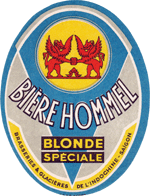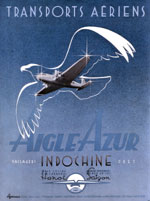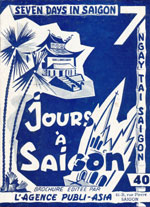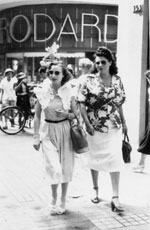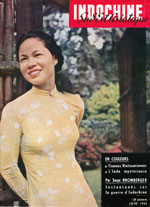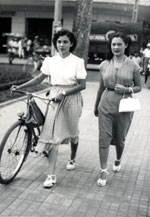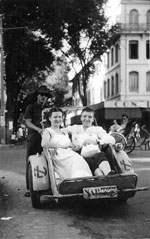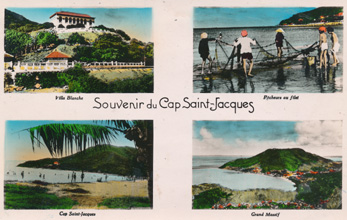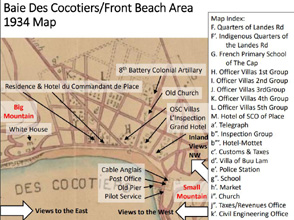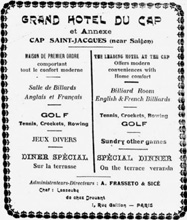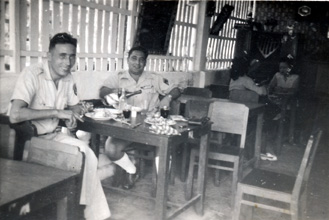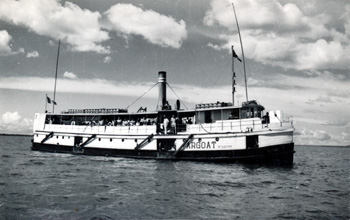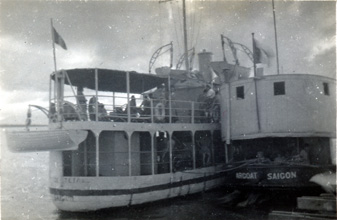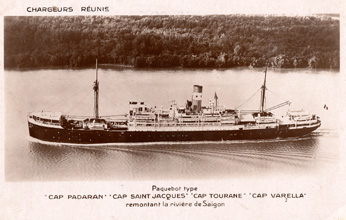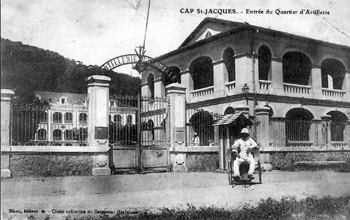


Compilation, identification and annotation
by Paul Thompson
V┼®ng T├Āu March 2020

Cape St. Jacques is located at the end of a small peninsula, 125 Km. Southwest of Saigon at the mouth of the Donnai (Dong Nai). It was named by Portuguese navigators who sailed along this coast in the 15th century and named it St. Jacques.

Baie Des Cocotiers/Front Beach: Views to the West 1934 Map
Baie des Cocotiers Panoramic view

Timeline for White House (Palace) - Villa Blanche - Bach Dinh
Residence/Usage
Compilation & Interpretation by Paul Thompson
Corrections, Updates, Additions Welcome
- 1898-1902: Construction
- 1902-1907: Unofficial Indochina Governor-General (Jean Baptiste Paul Beau)
palace/retreat
- 1907-1916: Emperor Th├Ānh Th├Īi residence during house arrest
- 1916-1925: Official Indochina Governor-General palace/retreat
- 1926-55: Emperor Bß║Żo ─Éß║Īi (Head of State from 1949) palace/retreat
- 1955-75: Presidents of South Vietnam/Military Junta palace/retreat
: Ng├┤ ─É├¼nh Diß╗ćm 1955-63
: Military Junta 1963-67
: Nguyß╗ģn V─ān Thiß╗ću 1967-75
- 1975-1991: Out of use
- 1991: First used as a museum
- 1992: Recognized as a national historical and cultural relic;
restoration and renovation into a tourist attraction.

Marine Nationale - the French Navy
The CommandantŌĆÖs office at Cape St. Jacques is located on Rue de la Concession near the Fisheries office and the R&R center.

Grand Hotel du Cap
The Grand Hotel du Cap was built in 1897 - The leading Hotel at the Cap.
Billiard Room - English & French Billiards.
Special Dinner on the terrace veranda.

La plage des Cocotiers - B├Żi TrŲ░ß╗øc (plage du Devant)
During the ŌĆś50ŌĆÖs, Cape St. Jacques was a beach resort and a R&R center for French soldiers.
- The MayorŌĆÖs office was located on the Boulevard des Landes.
- The Grand Hotel was on Lanessan Dock (across B├Żi TrŲ░ß╗øc).
Account of a French soldier staying at Coconut Beach on Cape St. Jacques:
ŌĆ”And this is why I was granted several days of R&R at Cape St. Jacques and thatŌĆÖs also where I took my first midnight swim!!!
What a pleasure it was to go out to the beach in the evening and to watch those large-shrimp fishermen, who, nearly naked in the water pulled in their nets where one could see the fluorescent eyes of these little creatures that we ate the next day.
It couldnŌĆÖt last, but we knew that. ItŌĆÖs not like what happened to those who came after us, and who were massacred in the same place where we were.
Jean Gourbil Decembre 1950
Indeed, on July 21st, 1952, an attack by the Vietminh resulted in 20 killed and 23 wounded in an R&R center at Cape St. Jacques.
Location of V┼®ng T├Āu/Cap St. Jacques Lighthouse

1862 The Lighthouse - Den Pha
This lighthouse is located on small moutain (massif du phare).
1911 The Lighthouse - Den Pha
The Cape St. Jacques lighthouse is located on top of the Telegraph mountain (now Nui Nho), with the present structure having been built in 1911.
It is 3 meters in diameter and 18 meters tall; next to it are four old French cannons (10 meters long and weighing several tons). They were formerly used to defend the region against naval attacks.
The lighthouse provides an exceptional panoramic view over the entire Cape St. Jacques (V┼®ng T├Āu).
It is fitted with a lighthouse lens designed by Henry Lepaute Company, located at 11, Desnouettes Street in the 15th district of Paris.
(Les Annales coloniales, 3 novembre 1910)
Les travaux de construction d'un phare sur le sommet du massif du Cap Saint-Jacques, en remplacement du phare actuel, sont poussés activement. Les caractéristiques de ce feu seront les suivantes :
Caractère : feu éclair à groupe de 2 éclats blancs, toutes les dix secondes ;
Forme : tour ronde en maçonnerie ;
Hauteurs : 1┬░ au-dessus du sol, 15 mètres ; 2┬░ au-dessus des hautes mers, 197 mètres.
C'est le 20 avril de cette année qu'ont commencé les travaux de ce nouveau phare dont la mise en service aura lieu probablement en février 1911.
1955 The Lighthouse - Den Pha
2020 The Lighthouse - Den Pha
After 1975 major modification with buttress support.
Lighthouse Profile Through Time
Showing Some Minor and Major Modifications


The S.O.S. bar at Cape St. Jacques
At the end of the ŌĆś40ŌĆÖs and beginning of the ŌĆś50ŌĆÖs, the S.O.S. bar was the meeting spot for the soldiers of the French Expeditionary Corps on R&R.
The charming bungalow lost in the greenery, thatŌĆÖs the S.O.S., a bar and restaurant lost in Indochina. You can get a drink (neat), you can eat (well), and you can dance (if you want to).
Its terrace swept by the sea breeze is the refuge of poets and dreamers (indeed, quite often both).
You can gaze at the sea to the horizon, white at dawn, red and gold at sunrise then going through purple pink and blue before the divine star sinks back into it.
At night, the lights of the junks and the luminous ray of the lighthouse play strange symphonies.
Jean Petersen
Cape St. Jacques in 1953
French soldiers eating fishes in Cape St.Jacques restaurant (Bar S.O.S. January 1953).
Preparing a fishes meal on the beach (Plage des Cocotiers August 1953).
The Foreign Legion in Cape St. Jacques
Foreign Legion in Cape St.Jacques ( March 1952).

The "Cap Saint-Jacques"
The "Cap Saint-Jacques" - Auxiliary Transport - September 3 1946.
The "Pasteur" at Cape St.Jacques
cinemaFrom October 1945 to February 1956 the "Pasteur" was one of the main cogs in the comings and goings of French soldiers. There were a total of 81 round trips between France and the Far-East.
The "Pasteur" off-loaded her first passengers offshore of Cape St.Jacques because her draft did not allow her to go up the Saigon river. Landing craft or small freighters like the "Saint-Michel" or the"├Äle dŌĆÖOl├®ron" took over from there.
Then she went on to Tourane (Da Nang) and then on to her final destination: the Bay of Along, the port of Haiphong being equally inaccessible for the same reason as that of Saigon.
The duration of these trips was 15 days for Saigon and 20 days for Haiphong.
The Cape St. Jacques Line in Saigon
The ship ŌĆ£ArgoatŌĆØ provided daily service from Cape St. Jacques (Rach Dua) to Saigon (dock near the Hotel Majestic), and the other ship providing the connection in the other direction was the ŌĆ£ArmorŌĆØ.
With the Armor and the Argoat Breton sailors were quite in evidence in this part of Indochina!!
At the end of the war in Indochina in 1954, the newly secured road would outpace the river link by halving the travel time, and the line would be abandoned in 1955.
Today the trip by hydrofoil (of Russian manufacture) from Cape St. Jacques (Vung T├Āu) to Saigon is made in 1 hour, 30 minutes instead of the 5 to 6 hours according to the tides at the beginning of the ŌĆś50ŌĆÖs.
On the way to Cape St. Jacques... in 1949
The ship "la Chaloupe" leaving Saigon at "La Pointe des Blagueurs" on march 2nd 1949.
The ship "Tetard" at Rß║Īch Dß╗½a (V┼®ng T├Āu) near "Argoat" on june 1949.
Ocean Liners near Cape St. Jacques
A Cape St. Jacques-type liner (Chargeurs Réunis Line) steaming up the Saigon River.
The liner ŌĆ£CambodgeŌĆØ (Messageries Maritimes Line) off Cape St. Jacques.
Photo Tay Ho
Photo Tay Ho - art portrait, amateur work, enlargement photos.
42, Market Square Cape St.Jacques.

Route de Ben Dinh/Le Loi Street Military Complex 1934 Map

Infantry Barracks - VietsovPetro
Junction of Pham Hong Thai & Le Loi
Artillery Barracks PV Gas
Quartier de l'Artillerie Coloniale







